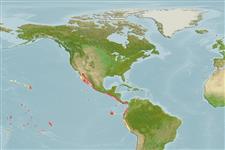Environment: milieu / climate zone / depth range / distribution range
Ecología
marino demersal; rango de profundidad 0 - 300 m (Ref. 9269), usually 0 - 95 m (Ref. 9269). Subtropical; 34°N - 15°S
Eastern Pacific: Santa Catalina Island, southern California, USA to Peru.
Tamaño / Peso / Age
Maturity: Lm ? range ? - ? cm
Max length : 33.0 cm TL macho / no sexado; (Ref. 55763); common length : 15.0 cm TL macho / no sexado; (Ref. 55763)
Short description
Claves de identificación | Morfología | Morfometría
Espinas dorsales (total) : 3; Radios blandos dorsales (total) : 12 - 14; Espinas anales: 0; Radios blandos anales: 8 - 9; Vértebra: 19. Branchiostegal rays: 6 (Ref. 36491).
Adults inhabit rocky areas, including the intertidal zone. Found on sandy and muddy bottoms (Ref. 9269). Young individuals feed heavily on crustaceans but as they grow bigger, they consume more and more fish, sometimes catching and eating fishes their own size (Ref. 4930).
Life cycle and mating behavior
Madurez | Reproducción | Puesta | Huevos | Fecundidad | Larva
Eschmeyer, W.N., E.S. Herald and H. Hammann, 1983. A field guide to Pacific coast fishes of North America. Boston (MA, USA): Houghton Mifflin Company. xii+336 p. (Ref. 2850)
IUCN Red List Status (Ref. 130435: Version 2024-1)
Threat to humans
Harmless
Human uses
Herramientas
Special reports
Download XML
Fuentes de Internet
Estimates based on models
Preferred temperature (Ref.
123201): 15.7 - 28.8, mean 23.3 °C (based on 270 cells).
Phylogenetic diversity index (Ref.
82804): PD
50 = 0.5312 [Uniqueness, from 0.5 = low to 2.0 = high].
Bayesian length-weight: a=0.02630 (0.01029 - 0.06725), b=2.96 (2.73 - 3.19), in cm total length, based on LWR estimates for this (Sub)family-body shape (Ref.
93245).
Nivel trófico (Ref.
69278): 4.0 ±0.66 se; based on food items.
Resiliencia (Ref.
120179): Alto, población duplicada en un tiempo mínimo inferior a 15 meses (Fec assumed to be > 10,000).
Fishing Vulnerability (Ref.
59153): Low vulnerability (23 of 100).
